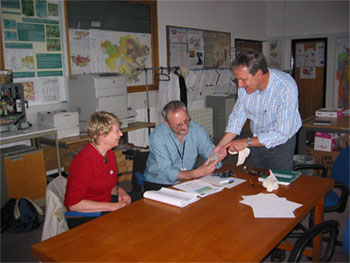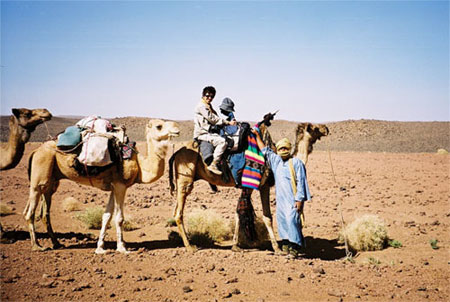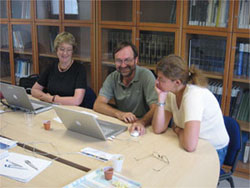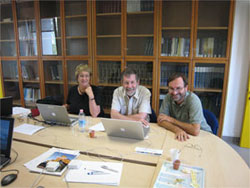GEMOC's international links
 |
 |
 |
 |
BACKGROUND
GEMOC’s international links provide leverage of intellectual and financial resources on a global scale, and an international network for postgraduate experience. International activity includes funded projects and substantial collaborative programs with exchange visiting programs in France, Norway, Germany, United Kingdom, Canada, USA, Taiwan, Italy, Spain, South Africa, China, Brazil, Japan, Thailand and the former USSR.

FUNDED COLLABORATIVE PROJECTS COMMENCED OR ONGOING IN 2007 INCLUDE:
- Collaboration in the CERCAMS project as part of the ARC Discovery project “Earth’s internal system: deep processes and crustal consequences” (see section on Funded Research Projects). The CERCAMS project is a major study of crustal evolution across the Altaides, led by the Centre for Russian and Central EurAsian Mineral Studies at the Natural History Museum, London (Dr Richard Herrington, PI on the Discovery Project, and Dr Reimar Seltman, left) and involving Russian research groups, a number of industry sponsors and GEMOC.
- Trace elements and fluids in diamonds and relevance to mantle fluids and processes with Professor Oded Navon (Hebrew University, Israel).
- Shear-induced segregation in ordinary chondrites, a collaborative project with Professor N. Petford (Bournemouth University, UK).
- Core formation and degassing of the Earth, a collaborative project with Dr S. Nielsen and Professor A. Halliday (University of Oxford) and Dr M. Rehkamper (Imperial College, London).
- Partitioning of chalcophile elements between metal, sulphide and silicate, a collaborative project with Dr D. Frost and Professor D. Rubie (Bayreuth University, Germany).
- Detailed 2-D and 3-D structure of the Kaapvaal Craton in several time slices, using mantle-derived xenocrysts: a collaborative project with De Beers.
- Global Lithosphere Architecture Mapping, involving analysis of crustal evolution, the composition of the lithospheric mantle and the interpretation of seismic tomography: a collaborative project with BHP Billiton and Steve Grand (University of Texas at Austin).
- Collaboration with Professor Massimo Coltorti and Dr Costanza Bonadiman from the University of Ferrara on the geochemistry of amphiboles, mantle metasomatism, and the age and origin of the lithospheric mantle beneath the Cape Verde Islands and Antarctica.
- TerraneChron® study to unravel the timing and tectonic history of regions in Tibet was initiated as a collaborative program with the National University of Taiwan (led by Professor Sun-Lin Chung), and has expanded to include collaboration with Nanjing University
- The nature of the lithosphere in Mongolia, and lithosphere extension in the Taiwan region, with Dr Kuo-Lung Wang (Institute of Earth Sciences, Academia Sinica, Taiwan).
- Collaboration with colleagues at the University of Jean Monnet, St Etienne, including Professor Jean-Yves Cottin, Dr Bertrand Moine and Dr Marie-Christine Gerbe (with reciprocal funding from both sides) expanded. A formal agreement between the two universities includes PhD exchange, academic exchange and research collaboration relevant to the nature of the lithosphere in the Kerguelen Archipelago, Crozet Islands and the Hoggar region of Algeria. In addition, studies on magma mixing in granites commenced with a new co-tutelle agreement (Anne Fonfrege).
- Trace elements in mineral inclusions in lower mantle diamonds from Juina, Brazil with Dr Felix Kaminsky (KM Diamond Exploration, Vancouver, Canada).
|

Dr Farida Ait-Hamou needed a camel caravan to sample the remote volcanoes of the Hoggar region, Algeria. |
- Igneous rocks, mineral deposits, lithosphere structure and tectonic setting: southeastern China and eastern Australia. This collaboration with Nanjing University has expanded from an AusAID grant under the ACILP scheme with Professor Xisheng Xu (Nanjing University).
- Studies with Professor Jianping Zheng (China University of Geosciences, Wuhan) on the evolution of the lithosphere beneath several parts of China, crustal evolution in the North China Block the Yangtze Block and southeastern China, and the UHP metamorphism of Dabie-Sulu peridotites.
- Studies on Cathaysia’s place in Rodinia, crustal evolution of southeast China, and crustal evolution of the Yangtze Block with Professor Jinhai Yu and Ms Lijuan Wang from Nanjing University.
- Studies continued with Dr Rendeng Shi (University of Science and Technology, Hefei, China) on the age and origin of platinum group alloy phases in podiform chromitites in ophiolites from Tibet.
- Analysis of off-craton lithospheric mantle in the East Central Asia Orogenic Belt and fundamental studies on the origin of diamonds, with Dr V. Malkovets, Novosibirsk.
- TerraneChron® analysis of Proterozoic terrains in Africa, North America and Europe, with BHP Billiton and several other mineral-exploration companies.
- Tectonic domains in southern Norway and Mozambique using TerraneChron® with Professor T. Andersen (University of Oslo) and Dr B. Bingen (Norwegian Geological Survey).
- Age and magma sources of Chilean Cu-porphyries, with Codelco (Chile) and the CSIRO Division of Exploration and Mining (Perth)
- Several collaborative projects were initiated with Dr Kreshimir N. Malitch (Department of Geochemistry All-Russia Geological Research Institute (VSEGEI), St Petersburg) including: (1) the nature and origin of zircons from the intra-continental paleorift-related ultramafic-mafic intrusions of the Noril’sk area (northern Siberia, Russia). The latter include world-class PGE (platinum-group element)-Cu-Ni sulfide deposits related to Noril’sk-1, Talnakh and Kharaelakh ultramafic-mafic intrusions, subeconomic PGE-Cu-Ni deposits related to Chrernogorsk, Zub-Marksheider and Vologochan intrusions, prospective Mikchanga intrusion and non-economic Nizhny Talnakh, Zelyonaya Griva and Kruglogorsk intrusions; (2) analysis of Os-(Ir-Ru) alloy grains derived from two world-class Au-PGE placer deposits associated with the Guli clinopyroxenite-dunite massif (northern Siberia, Russia) and the Evander Goldfield within the Witwatersrand Basin (South Africa). The main aim of this study is to place further constraints on osmium-isotope signatures of the mantle sources for Os-rich alloy grains at Guli and Evander, which (along with Witwatersrand grains) represent the oldest terrestrial platinum-group minerals known so far.
Refer to the Research Program and Postgraduate sections of this Report for details of other projects.

 GEMOC ARC National Key Centre
GEMOC ARC National Key Centre
